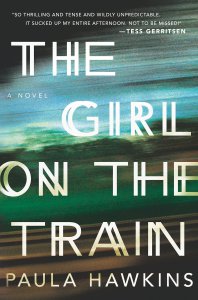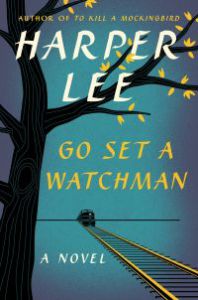3. The Girl On the Train (2015)

The fifth book of Paula Hawkins is actually the first one signed with her real name, why? The author herself explains that she felt that “it’s one last roll of the dice” and never felt comfortable writing romance books under a pseudonym. That was also seen in writing; with each volume, the stories were becoming darker. “Nobody bought the last one” Hawkins laughs.
Being in a position to try one last time or do other things, the author writes in six months “The girl on the train”. The fact that in a few months from appearance were sold over 120,000 copies already says enough, especially when compared with prior experience. Furthermore, the writer put it on the map of contemporary literature.
The Story
The girl on the train, Rachel, is the expression of insecurity and loneliness – perhaps this is why the contemporary reader, often lonely and insecure character resonated immediately. The young girl is starting to become obsessed with some people’s garden, which the train is passing by. Creating stories in her mind about the people there – having a perfect life, quite different from hers, marked by struggles with alcohol and marriage breakup.
One day she noticed something amazing, then the woman from the garden disappears. Rachel enters in the lives of those people without any more fantasies. This is where the difficulties of their own state – confusion, memory loss – which help prevent truth about the woman in the garden; nobody trusts the word of Rachel.
Paula Hawkins joins an outstanding line of women’s psychological thriller author (lead by Gillian Flynn). What divides them from male approaches is the lower appetite for serial murder and increased domestic topics and real-life threats. Central characters of authors almost always men are attacked by strangers, those created by women are assaulted by people they know.
This was just an example of the two approaches. From this perspective, “The Girl in the Train” (which is a grown woman) is more than an ordinary thriller: it’s the status of women in society, from addressing instinctive forms of violence prevention to rude lines of discrimination, going through aging, maternity, and perception in society.
The qoute says the author, who initially wanted to become a journalist and even practiced this craft for a while, on topics like taxes, pensions and mortgages. From here to the idea of creating a story from the simple gesture looking out a train’s window it’ a long road. And when the narrative is the thriller, the plot becomes even more acute.
2. Go Set a Watchman (2015)

Harper Lee hit … Literary again after the runaway success of the book “To Kill a Mockingbird,” which brought her the Pulitzer Prize in 1960. A giant retailer, Amazon.com, has announced that “Go Set a Watchman” the author’s so awaited second book, is the most recommended volume of the moment, 55 years after Gregory Peck gave life to the title character in the book that propelled her “first” world literature Lee.
The author shocked in February when, having reached a respectable age – 89 years – after a stroke which left her with some physical sequelae after a silence and isolation by the public for decades, announced that it will publish a book that almost no one knew it existed. And behold the character Atticus Finch, the protagonist of a screenplay Oscar, returns, 20 years after the adventures in “How to Kill a Mockingbird” when his daughter, Scout, now adults, return to visit in Maycomb, Alabama.
So, readers worldwide have to face a continuation of the first book, with the same famous lawyer Atticus, his daughter, his son, Jem, and their housekeeper, Calpurnia, all, as you know, the famous centre of the racial process that made the first book famous.
Two narratives
Although the two narratives are intertwined worlds somewhat, particularly due to the presence of the same characters, it is clear that they cannot be identical. Scout, the storyteller, is now a grown woman, and courageous, on the other hand Atticus is a septuagenarian plagued by arthritis.
The liberal hero with an advanced vision for his time, accused in the first book to be “black lover” and ostracized for it, puts in front of the reader a painful evolution: to the horror even his daughter, anti-racist attorney who is participating in public meetings today opposing implementation of integrated education and votes freely in the south!
On marvellous hero seems to have turned full “deep and complicated political nuances of the South” … It is almost inconceivable … we have to read to believe how the author shatters a character in a certain posture classicized and himself as a writer. So expect the appearance of this book in bookstores that gave millions of readers a “hot” appetite.
1. To Kill a Mockingbird (1960)

To Kill a Mockingbird is a novel by Harper Lee published in 1960. The novel had immediate success, winning the Pulitzer Prize and became a classic piece of modern American literature. The action and characters are inspired by the author observation of the family and its neighbors, and an event that took place in her hometown in 1936, when she was 10 years.
The novel is known for its warm tone and humor, although a serious problem dealing with topics such as rape and racial inequality. The narrator’s father, Atticus Finch, serves as a model of morality for many readers as a model of integrity for lawyers. One critic explained the impact of the novel , writing : ” In the twentieth century , To Kill a Mockingbird is perhaps the most widely read book about race in America and its protagonist , Atticus Finch , the persistent image of racial heroism fiction ” .
As a Southern Gothic novel genre and as a Bildungsroman, the main themes of To Kill a Mockingbird involve racial injustice and the destruction of innocence. Critics have noted how Lee deals with themes related to social class, courage, compassion and gender roles in the historical region called Deep South. The book is part of the curriculum of many schools in the Anglophone countries (where the focus is on deplores tolerance and prejudice) and in the English literature and world literature from other countries.
Despite the topic addressed, To Kill a Mockingbird has been subject to campaigns of elimination from public school curricula, often challenged for racial epithets use. Critics have observed that the color of the novel characters are not explored in depth, and some black readers disagree ambivalent about it, although often has a greater impact on white readers.
The second novel by American writer Harper Lee “Go Set a Watchman” exceeded its launch in the US in bookstores all sales records for a book of fiction for adults, announced major bookstore chain Barnes & Noble.

